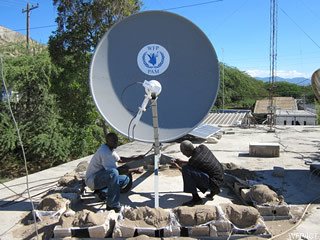WBMSAT Satellite Industry News Bits for January 29, 2010
Friday, January 29th, 2010Eutelsat confirms full restoration of services from W2 satellite on capacity on three satellites at 16 degrees East including EUROBIRD(TM) 16 and SESAT 1, as W2 is placed in secure standby mode for investigation of anomaly.
[Street Insider – 01/29/2010]
Arianespace and European Space Agency executives sign contract defining Arianespace’s support services for the qualification campaign and testing of the Vega light launcher.
[SatNews – 01/29/2010]
Israeli satellite fleet operator Spacecom leases Amos 5i, formerly Asiasat 2, and signs with SpaceX to launch a satellite, probably Amos 4.
[Space News – 01/29/2010]
Newtec FlexACM is used by Gateway Communications’ Aftrica-wide Internet backbone service to double satellite link capacity.
[SatNews – 01/29/2010]
Telesat sells Telstar 18 broadband capacity over Mongolia.
[Satellite Today – 01/29/2010]
Sirius XM to broadcast Super Bowl in 10 languages, with 14 different live broadcasts plus live talk programming from South Florida throughout Super Bowl Week.
[SatNews – 01/29/2010]
U.S. Air Force is concerned about vulnerability of satellites, especially GPS satellites, to threats like the capability it believes China is developing, to attack American military satellites. It is proposing to use high flying aircraft, UAVs, or blimps to take over communications duties.
[Strategypage.com – 01/28/2010]
Eutelsat confirms that its W2 satellite suffered a technical anomaly on January 27, and is proposing alternative capacity to all customers affected by the anomaly.
[PRNewswire – 01/28/2010]
Intelsat General is awarded five-year contract to provide C-, Ku, and X-band capacity, earth stations, terrestrial backhaul, and bandwidth management services to U.S. Space and Naval Warfare System Command division.
[Satellite Today – 01/28/2010]
Globecomm Systems announces that rural Pennsylvania and Nebraska wireless operator Indigo Wireless is latest carrier to use Globecomm’s 3G switch platform.
[SatNews – 01/28/2010]
Hughes Network Systems announces successful demonstration of SPACWAY 3 broadband capabilities during Coalition Warrior Interoperability Demonstration, including successful demonstration of HD video teleconferencing.
[SatNews – 01/28/2010]
SES WORLD SKIES reaches new DVB service deal wiith Microspace to deliver global retailer’s digital signage campaign to clothing stores throughout Europe.
[SatNews – 01/28/2010]
The Indian Space Research Organisation (ISRO) receives several proposals from the international community for payloads to be carried on its Chandrayaan-II moon mission.
[Moon Daily – 01/28/2010]
America’s first commercial spaceport, Spaceport America, starts to take shape in New Mexico’s desert.
[Space.com – 01/28/2010]
University of Colorado at Boulder is selected along with Montana State University and Kentucky Space as universities to have research satellites launched in November as part of NASA’s space-education initiative.
[Denver Post – 01/28/2010]
RRSat launches new platform for Iberian market on Hispasat satellite.
[PRNewswire – 01/28/2010]
Program support for first ever International Conference on Orbital Debris Removal, co-sponsored by DARPA and NASA, bringing together 300 scientists and researchers from around the world, is provided by Agilex.
[SatNews – 01/27/2010]
India plans manned space mission in 2016.
[Space Travel – 01/27/2010]
Proton carries Russian defense ministry satellite aloft; satellite will relay communications between troops and military commanders.
[Spaceflight Now – 01/27/2010]
NASA’s plans to return astronauts to the moon, along with rockets designed to take them there; may be dead if Obama gets his way.
[Orlando Sentinel – 01/27/2010]
Anianespace to launch first ten Galileo satellites.
[Space Travel – 01/27/2010]
SES ASTRA signs with Italian public broadcaster Rai to provide satellite capacity for the broadcast of Rai’s new theme-based channel throughout Europe.
[SatNews – 01/27/2010]
Russia working on new booster rocket; said it should be completed by August.
[Space Travel – 01/27/2010]
Russia set to launch manned spacecraft in 2017; will start building its new space center, Vostochny, in the country’s Far East in 2011 for completion by 2018.
Space Travel – 01/27/2010]
Iridium offers satellite data links for management and recovery with remote communication network sites.
[Globe Newswire – 01/26/2010]
Telecomes San Frontiers, supported by the European’s Commission Humanitarian Aid Department, provides high speed connections and services to over 200 humanitarian organizations in Haiti.
[SatNews – 01/26/2010]
Looming China challenge to America includes capability to disable American military satellites.
[NY Post – 01/26/2010]
Thales Alenia Space is awarded contract to provide ESA Galileo system support services from 2010 through 2016.
[SatNews – 01/26/2010]
Satellite Industry Association finds that during the Iraq invasion over 80% of all military satellite communication was over commercial satellites; U.S. Navy plans to deploy 200 high capacity terminals designed to communicate over commercial satellites.
[Defense Industry Daily – 01/26/2010]
India’s new cryogenic rocket engine develops problems, delaying the debut of India’s most powerful rocket for launching geosynchronous satellites.
[Spaceflight Now – 01/26/2010]
Inmarsat global phone, the new IsatPhone, successfully makes its first call.
[GEARlog – 01/26/2010]
RapidEye announces completion of baseline image campaign covering Helmand river basin in Afghanistan to assist U.N. and U.S. efforts to suppress production of opium.
[SatNews – 01/26/2010]
Americom Government Services works with MTN to provide additional satellite capacity to U.S. Navy to improve communications into Haiti within hours after earthquake.
[Wireless Design Online – 01/25/2010]
Satellite communications providers experience dramatic increase in demand from agencies and organizations deploying to Haiti.
[Urgent Communications – 01/25/2010]
GATR Technologies sets up internet cafe in Port au Prince, Haiti.
[Huntsville Times – 01/25/2010]
Harris selects Telesat’s new Telstar 11N to provide Atlantic Ocean region coverage for Harris Maritime Communications Services maritime broadband product using iDirect platform.
[SatNews – 01/25/2010]
SES building three new satellites, to be named SES-1, SES-2, and SES-3, and will rename other satellites in the SES fleet using the same convention.
[SatNews – 01/25/2010]
Rockwell Collins, through its recent acquisition of DataPath, wins three-year $9.2M contract to provide maintenance and field service for Air Force’s Ramstein Air Force Base teleport.
[Military & Aerospace Electronics – 01/23/2010]
NASA extends the World Wide Web into space, as astronauts gain direct personal access to the Web via the ultimate wireless connection; astronauts make first direct space twitter.
[NASA.gov – 01/22/2010]
NASA plans to boost speed of deep space communications by fusing together three old networks into a single, much faster, more efficient data network 50 times faster.
[Space.com – 01/22/2010]
European Space Agency expects to finalize plans for proposed data relay satellite system and get it funded in 2010.
[Spaceflight Now – 01/22/2010]
Iridium unveils smaller, lower-cost data transceiver, a full-duplex short-burst Data (SBD) transceiver for growing asset tracking and monitoring market.
[Space Mart – 01/21/2010]
KVH makes an iPhone app available to boat owners to interface with the TracVision Antenna Control Unit for status of their KVH TracVision DirecTV HD downlink system.
[SatNews – 01/18/2009]
WBMSAT PS – Satellite Communications Consulting Services


















